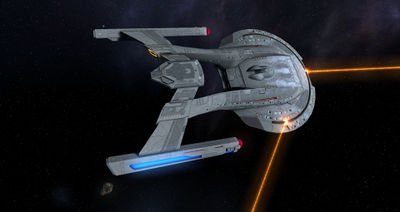
A phaser array is a devastating weapon comprised of an arrangement of phaser emitters located in strategic areas of a starship, space station, or other vessel. In the 23rd century, phaser arrays had smaller numbers of emitters, and were commonly referred to as phaser banks. By the 24th century, Starfleet began to fit its vessels and facilities with phaser arrays that contained much larger numbers of emitters. The arrays aboard a Galaxy-class starship could channel vast energy in a short time frame, capable of cutting through a mile of solid granite in seconds. During the firing sequence of some shipmounted arrays, phaser energies would travel along the emitter strip and converge at the best position for targeting.
Configuration Classifications
Emitter
Phasers can operate as part of one of many different system configurations, however all systems share the emitter component. While other systems such as the bank or array make use of multi-emitter architecture many platforms, predominately small craft, still use the single emitter system. Differing little from the emitter on smaller hand weapons such as pistols and rifles, the emitter is the least complex and physically smallest phaser system. The differences that are most easy to identify between a starship emitter and the hand held version is the omni-directional firing capability of the starship emitter. Benefiting from computer assisted targeting, the phaser emitter is generally configured to allow for the phaser system to release the beam in almost any direction. This allows the weapon to track and fire at moving targets without the need to physically move the weapon system itself with the target it is engaging. This allows a ship's primary emitter (whether singly or as part of a bank or array) to successfully engage small, fast moving targets such as asteroids, auxillary craft, or fighters.
Bank
A phaser bank is simply a pair of emitters that utilize shared power and targeting systems. Beginning in the 2250's, Starfleet engineers began to research methods to increase phaser output and efficiency. While much of this research would eventually lead to the development of the Type-VII phaser system, another group of engineers would discover the benefits of a bank system almost by accident. A paired set of emitters operating from each phaser system dramatically increased the amount of power that could be channeled by allowing it two separate outputs instead of channeling it through a single emitter system. By 2255 the bank configuration had all but replaced single emitter systems in use on all starships. The emitter systems used in Starfleet phaser banks resemble a squat cylinder topped with a half sphere in cross section, with the sphere section housing the emitter itself and protruding above the surrounding hull.
Array
The phaser array has its genesis in efforts to increase phaser efficiency even farther in the early 24th century. For years Starfleet engineers had experimented with increasing the number of emitters as part of phaser bank systems with little success. It seemed that the addition of more and more individual emitters did not create the same sort of increases that the paired emitter systems had. However, engineers working at the newly opened Jupiter Station facility developed a new system that worked by bridging the various emitter systems together to form one continuous array. The increase in power the combined array system could channel was significant, and results were even better still when those working on the project redesigned the individual emitters into joined emitter segments instead of bridging the individual emitters themselves. In cross-section, the phaser array takes on a thickened Y shape, capped with a trapezoidal mass of the actual emitter crystal and phaser-transparent hull coatings. The base of an array segment sits within the hull itself.
Array systems are different from the bank, emitter, and even pulse phaser systems in that the phaser armament and power of an individual vessel or design has far more to do with the number of emitter segments that make up any of its arrays then it does the simple number of arrays it carries. For example, it might be easy to think that the Intrepid-class with thirteen Type-X arrays would have more phaser power at its disposal then a Nebula-class with 8. However, the large number of emitter segments that make up the dorsal and ventral saucer arrays on the Nebula, much like those mounted on the Galaxy-class, make those arrays some of the most powerful Type-X arrays ever mounted on a starship. As such, the two main arrays are capable of more power then most of the arrays on an Intrepid put together. In addition, unlike the earlier bank systems, the array configuration allows the engagement of multiple targets at the same time. The larger arrays can engage more targets simultaneously or in quick succession while still maintaining optimal power output along each beam to each target. In essence, the main array on a Galaxy or Nebula can engage the same number of targets that several smaller arrays together could engage.
Pulse
The pulse phaser, also known as the phaser cannon, was a weapon system developed as part of the Defiant-class project. With the ability of the Borg to adapt to various phaser settings, Starfleet designers attempted to develop a phaser weapon that could deliver higher damage output per strike then a typical beam phaser where the maximum power output was reached over time. The result was the pulse phaser system that combined several new technologies, such as nearly flawless emitter crystals, rapid discharge EPS capacitance banks and high-speed beam-focusing coils. The energy emissions of pulse phasers are stored in a magnetic field, allowing them to coalesce and agitate to higher energy states. The field is then redirected, forcing the burst of phaser energy toward the target. This process is repeated rapidly using multiple magnetic field generators, and the result is a stream of phased energy projectiles. Although the effective range of such a weapon is less than the standard beam based phaser due to rapid dissipation, at optimal ranges the pulse phaser can do more damage than most other phaser types. The other limitation aside from range with the pulse phaser system is that it is far more akin to an unguided projectile weapon in that the bursts can only be directed in a single direction along the emitter. As such, deployment of the pulse phaser system has so far been limited to highly maneuverable platforms such as the Defiant-class and fighter craft.
Phaser Types
Type-IV
The Type IV phaser is the lowest power phaser used on starcraft. Generally deployed as a mobile or fixed emplacement weapon for ground forces, the Type IV phaser system is use most often in stellar applications to outfit unarmed shuttles for mission specific uses. These weapon systems are usually of little tactical use and are instead fill the role of scientific instrument or tool when used on shuttles.
Type-V
The Type V phaser is a weapon type used to provide small shuttlecraft with a phaser system to serve a tactical function.
Type-VI
The Type VI phaser systems the standard phaser type used on runabout platforms throughout Starfleet. Phaser systems of this power output were first introduced in the mid-2240's as the primary armament on early Constitution-class vessels at the time of their construction. These weapons were also some of the first in Starfleet to utilize the bank arrangement.
Type-VII
Type VII weapons are utilized on older vessels such as the Oberth-class and Miranda classes. These weapons generally are seen on Starfleet platforms using bank arrangement weapons that have not been upgraded to the Type VIII specification.
Type-VIII
These phasers are usually the highest mark type found aboard Federation starships using bank style weapons. As such, they are most often found on Excelsior and Constitution class vessels.
Type-IX
Type-IX phasers were initially fielded aboard Ambassador-class starships. The first phaser class to be designed primarily for use in array systems, Type-IX systems first found widespread use starting in the late 2320's. They are still found today on starships that cannot operate the Type-X arrays for reasons of power distribution system limitations.
Type-X
The Type-X phaser array is the standard phaser array on most Starfleet vessels. Many vessels from light cruisers to full fledged Galaxy-class explorers mount the Type-X as their standard phaser weapon. The development of the Type-X phaser system was initially part of the Galaxy-class and related development projects, and as such first saw use beginning in the late 2350's.
Type-XI
Designed during the same time as the Type-X phaser, the Type-XI was originally designated the Type-X+ for security reasons. The Type-XI has been used in dedicated planetary defense systems since its inception and was deployed as the main armament of many starbases at the time. Type-XI systems used in planetary defenses are designed to minimize atmospheric blooming of the beam. The Type-XI was unsuitable for use on a starship platform because the energy requirements of the array were overly high and the supporting hardware oversize.
Type-XII
The Type-XII phaser is the most powerful phaser type to see large scale front line deployment with Starfleet. A result of advances in phaser emitter development in 2370, Type-XII emitters offer more power in a more compact system then the Type-XI but are still larger and more power intensive then Type-X. As a result, the Type-XII sytems are mostly found on larger starship designs created after its development or on combat focused vessels upgraded to include them following the initial design phase.
External Inforamtion
- Phaser Array at Memory Alpha
